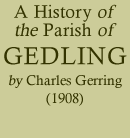< Previous | Contents | Next >
Carlton.
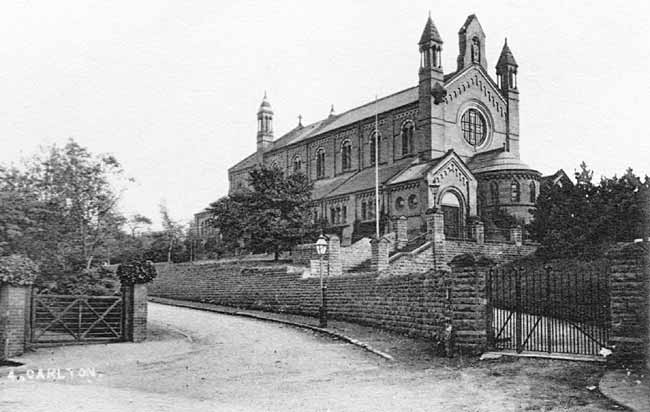
Carlton Church, St. Paul's.
THIS place name is derived from the Anglo-Saxon "Ceorl"—a freeman of the lowest rank, a countryman, a churl, a husbandman, also a man, a husband, or a freeman.
It must have been an estate occupied by free tenants at the will of the Lords or owners, it does not appear in Domesday like the other Carletons.
Mr. William Stevenson has a note, "Cherl," a serf, a copy-holder, a man of mean birth and condition. Thus "Ceorl"and "ton "would mean the township of certain Freemen who occupied the land at the will of the Lord of the manor.
The acreage of Carlton is 1470.534, and is bounded on the North by Gedling, on the East by Stoke Bardolph, on the South by Colwick, and on the West by Nottingham.
Carlton was a beacon hill in the seventeenth century, and no doubt long before, it is delineated in Ogilby's "Book of Roads."
From Nottingham Borough Records, we quote the following field names, lanes, &c. Moor Lane, Pinfold Bank Lane, Mill Field, Cloven Mear Lane, Fox-hill Lane, Standhill Butts, Standhill Close, Nottingham Field, Cowdale Common, Little Fox-hill Close, Great Wickett Close, Sixteen Land's Close, Little Wickett Close, Butter Close, Black-hill Close, Brick-kiln Close, Earning- Wood Close, Mellor's Lane, Far Riding Close, Deep Furrow Close, Acrehavedes, Alkenthwyt, Auc Stocking-, Blackbifl, The Brakethweyt, Bugge Riding Yarde, Carlewode Boske, Dike (Ditch) Dounecroftdale, The Halugb, The Halugh, called the Short Wong, The Hold Cros, The Holtes, Holte Steygh (Sty=a path), Kydale Bekk, Kydale Gate, The Long Steny, The Middwifarlong in Rycroft, The Morfur-long, The Noxthentwells, The Rouwestockyng, The Rycroft, The Short Wong, called the Halugh, The Swaynes Gores, The Westdale, The Wode-Yierd.
We find from Gedling Parish Award Book, mention of private roads to be made in Carlton:—Nether-Field Road, Mill Field Road, Private Road on the bottom of the Great Hill.
In "Rentals and Surveys; Notts. 41 Edward III.," we find:—
Rentall' Rob'ti fil Rob'ti de Hayton fact' die sa clemet' Anno r r E t'cij a conqstu xlmo p'mo 't Anno D'm mmo cccmo lxmo vijmo0 de Hayton. clarborgh. Wellu'. retforth. clu'b'. lound. Walkryngham. mist'ton. stoketh. suthleu'ton. Ratclyf sup' trent. carlton uxa gedlyng. colston Basset 't de stapilforth.
[Translation—"Rental of Robert the son of Robert de Hayton made on St. Clement's day (23 November) the year of the reign of King (r.r.=regni regis) Edward III. after the Conquest the 41st & Anno Dom. 1367 concerning Hayton, ClarboroughK Wellow, Retford, Clumber, Lound, Walkeringham, Misterton, Stokeham, South Leverton, Radcliffe-on-Trent, Carlton next Gedling, Colston Basset, and Stapleford."]
Carlton Church, (St Paul's) Interior.
Carlton iuxta Gedlyng
De Gregorio Lyly, natiuo [nativo]*------------- xs
De Johe de Betlay--------------------------------xxs
De Thoma talior-----------------------------------xs
The names of inhabitants of Carlton assessed in the Lay Subsidy of 1525 will be found on pages 151-152 ante. The householders of Carlton assessed for the Hearth Tax of 1663, with the names of those exempt, will be found on pages 156-157. From this return it would appear that there were then forty-seven houses in the place, that occupied by Henry Truman being the largest.
Curtis's "Topographical History of Nottinghamshire," circa 1843-4, states:—
"Carlton. Carcutune. Carlton near Nottingham. Parish of Gedling, 2½ miles E. by N. from Nottingham, and 126 from London; in Basford Union; contains 440 houses, 2202 inhabitants, chiefly employed in framework-knitting and the manufacture of bobbin-net lace, and about 1400 acres of clay and gravelly land, the surface hilly; its expenditure in poor-rates £773 0s. 11¾d. A small brook traverses the lordship, which runs into the Trent below Colwick. The principal landed proprietors are the Earl of Chesterfield, and Earl Manvers, who is Lord of the Manor. Twenty shillings are annually distributed to the poor of Carlton, the bequest of John Aslin, who died in 1803. Owing to its contiguity to Nottingham, this township has doubled its population within the present century; such is the impulse given by the rapid increase of manufactures : the parent village, Gedling, at about 1½ miles farther from Nottingham, has during the same period diminished one-fifth. The Baptists and the Wesleyan Methodists have chapels here. The lordship was inclosed in 1792."
*Possibly "nativo" carries the additional significance that Lyly was a bondman attached to the soil!
From White's "Directory of Nottinghamshire," for 1853, we learn that the Poor's Land of Carlton was formerly 20/- yearly out of the estate of the late John Aslin, who died in 1803, but the poor lost their claim through the carelessness of a Trustee, who misplaced the Title deeds.
In August, 1894, while excavating for a new sewer in Brook-street, Carlton, the workmen discovered many evidences of a much older Carlton, including both antiquities and animal remains, such as are usually found on disturbing sites occupied by man for ages. The following descriptive remarks are by Mr. Richard Whitbread, public surveyor of Carlton, in 1902 :—" Head of cross, found 1894, a few feet below the ground, at the brook side, in the corner of a garden at the bottom of Urban-road, Carlton. Date, circa 1390. On the same site were found several large rectangular stones, which, I believe, were the loose stones of this (? boundary) cross. Quite close to the site, at 10 feet down, we found numbers of skeletons of the horse, ox, hog, &c, and a lot of long fir trees, which had a phenomenal appearance. Professor Carr thought they formed a deposit about the time of the Roman Conquest. It is possible the 14th century inhabitants may have built this cross to replace a former one, which marked a spot of importance.
Carlton-in-the-Willows was constituted a separate Ecclesiastical Parish by an Order of Her Majesty in Council dated 23 August 1883. The boundaries of the new parish were thus defined:—"All that portion of Carlton old township separated from Netherfield by the Midland Railway and to the left of the road from the Carlton railway station of the Midland, passing up the street now called Station Street and turning up the Gedling Road to Westdale Lane, and so on to the Mapperley Plains. All that is on the left of that course is in Carlton new parish for ecclesiastical purposes."
The Rev. Allan George Munro Meugens, M.A., was instituted the first Rector on the presentation of the Earl of Carnarvon. A parsonage house was built, and the church commenced, in the following year, both at the cost of the Patron, the net value of the benefice being then returned at £350 per annum, including 54 acres of glebe.
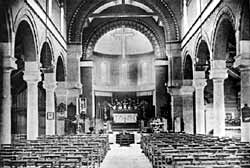
Carlton Church, (St Paul's) Interior.
The first portion of the Church, consisting of the chancel and two bays of the nave, built in the Lombardic style of architecture, was consecrated by Dr. Ridding, first Bishop of Southwell, on May 5th, 1885. The remaining portion of the fabric, which is dedicated to St. Paul, was consecrated by Dr. Ridding on February 24th, 1891. The Church is of red brick, with stone dressings, in the style of the Roman Basilica; it consists of a chancel with apse forming the sanctuary and a large vestry, nave of six bays, with an apse at the west end forming a baptistery, north and south porches, and western turrets, in one of which hangs a bell, given in 1885 by the late Rev. Kirke Swann. The completed church will seat 650 persons. The Earl of Carnarvon having died during the erection of the Church, his eldest daughter, Lady Winifred Gardner, wife of Mr. Herbert Coulston Gardner, M.P. (who was in August 1895 raised to the peerage as Baron Burghclere) unveiled a memorial stone outside the east end of the chancel bearing the following inscription :—"To the Glory of God. This Church dedicated to St. Paul was erected by Henry Howard Molyneux 4th Earl of Carnarvon to the memory and in fulfilment of the wishes of his wife Evelyn* Countess of Carnarvon, 1890."
* First wife of the fourth Earl of Carnarvon and only daughter of the sixth Earl of Chesterfield. Died 25 January 1875. See page 21 ante
A memorial brass in the south aisle is inscribed:— "To the Glory of God and as a thank offering for this Sanctuary this Tablet is erected by the Parishioners in ever grateful memory of Henry Howard Molyneux 4th Earl of Carnarvon the Patron of this Benefice and the Builder of this Church who was called home June 28th 1890. ' I believe in the Communion of Saints.'"
The present Countess of Carnarvon placed 10 the chancel a massive wrought-iron hanging cross, and on the western gable a life-sized statue of St. Paul, in memory of the deceased peer.
The oak choir stalls, the marble steps to the choir and marble lectern-stand were all given by the united effort of members of the congregation. A large number of other gifts—carvings, pictures, altar furniture, etc.— have been made to the Church, in memory of deceased parishioners.
Rectors of Carlton
Allan George Munro Meugens, M.A., instituted in 1883 by the Bishop of Lincoln, on the presentation of the Earl of Carnarvon. Resigned 18 August 1893. Rural Dean of Gedling from 1886 to 1893. Vicar of St. Bartholomew, Southsea, since 1893.
Edward Amyatt Amyatt-Burnby, M.A., instituted 22 September 1893, on the presentation of the Earl of Carnarvon. Resigned 2 January 1896. Has been Rector of Uphill, Weston-super-Mare, since 1906.
Frederic John Perry, instituted March, 1896, on the presentation of the Earl of Carnarvon.
In connection with the presentation of a piece of silver plate to the late Canon Forester in April 1883, by his parishioners at Carlton and Netherneld, the following remark appears in the Gedling "Parish Magazine" for June 1883:—
"We should add that there is a great future both for Carlton and Netherfield, both will soon become important places, and if we look a little ahead we are sure that each will soon be very populous; and see what the Rector of Gedling has done to provide for the spiritual need of this rapidly increasing population—he has made each of them a separate Rectory, and has endowed each with £10,000. This arrangement will shortly take effect."
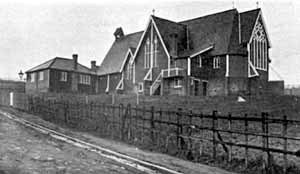
St. Michael's Church, (Porchester) Carlton.
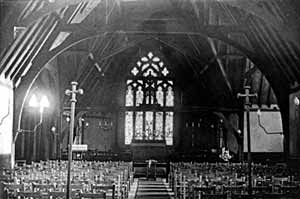
Interior. St. Michael's. Carlton.
The Church of St. Michael and All Angels, Porchester, built of brick and wood, was moved from Wallington, Surrey, in 1907. It was dedicated by the Bishop of Southwell on December 14 of that year.
It will seat about 300. Attached to the building is a Parish Room used for social purposes.
The Church contains a 14th Century Font; which was discovered some years ago by the Rev. E. St. J. Morse doing duty as a pump trough in a farm yard in his Parish of Shelford. It may possibly have been the Font of Shelford Church prior to the 17th Century.
The Church also contains a stone pulpit given by the Rev. the Hon. R. M. Dalrymple, which was originally in Sneinton Church.
The Wesleyan Methodist Chapel in Carlton was built in 1807, the Baptist Chapel in 1823, the United Methodist Chapel in 1853, and the Wesleyan Association was formed in 1844.
The Roman Catholic Church, in Main Street, dedicated to the Sacred Heart, and erected at a cost of £1,000, was opened in March 1884 by Bishop Bagshawe, of Nottingham. The building is of red brick, with stone dressings—in the early English style, consisting of nave only; the altar is of Bath stone, supported on marble columns. Sittings have been provided for no persons.
A Baptist Chapel, with Sunday School, was erected in 1901 at a cost of £4,000. The building is red brick with terra cotta dressings.
The cemetery of about six acres has been laid out near Chapel Lane, with Mortuary Chapel and residence for the caretaker. The cemetery was, at the request of the Local Board, consecrated by the Bishop of Southwell, 3 August 1886.
In 1873 the Hon. and Rev. O. W. W. Forester, late Rector of Gedling, built and fitted up a Working Men's Club and Institute, in memory of George Philip Cecil Arthur, 7th Earl of Chesterfield, and Sophia Elizabeth, the Hon. Mrs. Forester, at a cost of £2,500, the Earl of Carnarvon having presented the site. It was opened by the Earl of Carnarvon, 29 September 1873. It comprises concert or lecture hall, news, reading, and class rooms, with bowling green, skittle alley, and refreshment room, and is controlled by a committee.
On November 11th, 1875, the members of the Gedling and Carlton Working Men's Institute had a supper to celebrate their entrance on the third year of the club's existence, and also to do honour to the founder and president of the Institution, the Hon. and Rev. Canon Forester, by presenting to him an address, congratulating him on his recent marriage, and thanking him for his munificent gift of the hall and buildings for the club. In his reply to the address, Mr. Forester said—"You are good enough to ascribe it to generosity on my part that you have this Institution. Well, I will not argue about a word, nor do I mean to say that the building has not cost a considerable sum of money, but whatever it has cost, it has been an outlay that has returned to me a vast amount of satisfaction. In my life I have spent first and last a good bit of money in bricks and mortar, some of it (perhaps a good deal) I should be glad to have back again, but not that which has enabled me to erect this building here, for it gives an opportunity to the residents in this parish to meet daily, if they have a mind to do so, in an independent manner, and enjoy themselves with rational intercourse if they will, but at any rate socially and sociably."
The Temperance Hall was built at a cost of £600, defrayed by the late Rev. Lord Forester, and the late Mr. Samuel Morley.
The Carlton School, erected in 1878, provides for 214 boys, 154 girls, and 300 infants; another school for 400 (mixed) children was erected in 1872; and in 1906 the Porchester School, for 240 children, was erected. St. Augustine's Catholic (mixed) School provides accommodation for 108 children.
The Carlton Free Library was erected in 1906, at a cost of £2,050 on a site given by the Earl of Carnarvon, Andrew Carnegie, Esq., contributing £1,800.
There is a M.R. Station at Carlton, and a G.N.R. Station at Netherfield, which serves Colwick as well.
The Fire Brigade Station was built in 1906 at a cost of £550.
Earl Manvers, and the Earl of Carnarvon are Lords of the two Manors, and both hold courts leet.
Carlton was governed by a Local Board from 1881 until the Local Government Act, 1894, established an Urban
District Council—the district is divided into three wards, viz:—Carlton, Netherfield, and Porchester. Part of Carlton civil parish was by Local Government Board Order No. 31,837, added to Nottingham County Borough and civil parish.
Carlton Urban District Council
Mr. William Brettle (Chairman).
Mr. Arthur Cross (Vice-Chairman).
Carlton Ward :—Messrs. W. Bradley, W. Brettle, R. Godfrey, S. Robinson, W. H. Sheppard, J. Smith.
Netherfield Ward:—A. Cross, G. Green, J. T. Pearson, W. Price, S. Smith, C. Dunk.
Porchester Ward:—H. Cox, F. Lane, J. Stanton.
Officers:—Mr. Edgar W. Turpin (Clerk); Mr. Henry Russell, Lloyds Bank (Treasurer) ; Mr. John T. Knight, M.R.C.S.Eng. (Medical Officer of Health); Mr. James C. Haller (Surveyor); Mr. John E. Truman (Sanitary Inspector) ; Mr. William Peck (Collector).
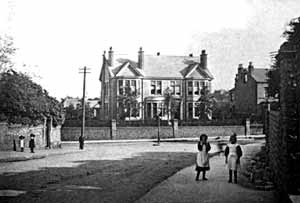
Division of Gedling and Carlton Parishes.
The area of the Urban District and civil parish is 1,453 acres of land and six of water; rateable value, £36,728; the population in 1881 was 4,625, and in 1891 6,914 in the civil parish and 6,627 in the Urban District, and in the civil parish and Urban District in 1901, 10,041, viz., Carlton Ward, 5,395, and Netherfield Ward, 4,646. The population of the Ecclesiastical parish in 1901 was 5,326.
It is stated in the latest County Directory that Carlton " has grown into a straggling town ; from the hills above extensive views are obtained of Nottingham, the Vale of Trent, and the surrounding country."It will be seen on the map that between the Pinfold at Stoke Bardolph and a point marked near the top of West Dale Lane, a distance of 31/6 miles, the land rises from 65 feet to 400 feet above sea-level. With regard to the characteristics of the thoroughfares the late Rector of Gedling (Parish Magazine, January 1881) after referring to the building operations of the Carlton Land Society in Fox Hill Gardens, draws this sharp contrast:—"Look at the honest breadth of way in it, with the houses set well back from the footpath, and the nice garden plots at the back; and contrast that with the 'cribbed and cabined' public highway between Carlton town end and the Carlton Schools, which by the Parish Award ought to be 'a carriage, bridle, and drift road, of the breadth of forty feet,' but is not, in some places, half that breadth. There has been foul work, if robbery is foul work in ' the good old times.'"
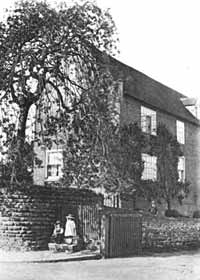
Old Manor Farm. Carlton.
The writer of these notes is quite aware that the Parish of Carlton is treated very concisely, or may appear so—but he would point out that until quite recently Carlton was a place of very little consequence, though at the present time its size, or shall we say importance commercially, is much greater than the Mother Parish of Gedling, and as the writer's aim all along has been to note historical facts, it will easily be seen why Carlton occupies so little space in this History.
